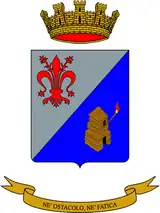| 43rd Signal Regiment | |
|---|---|
| 43° Reggimento Trasmissioni | |
 Regimental coat of arms | |
| Active | 1 Oct. 1975 — 8 Sept. 1998 |
| Country | |
| Branch | Italian Army |
| Part of | 3rd Signal Regiment |
| Garrison/HQ | Florence |
| Motto(s) | "Né ostacolo, né fatica" |
| Anniversaries | 20 June 1918 - Second Battle of the Piave River |
| Insignia | |
| Signallers gorget patches | |
The 43rd Signal Regiment (Italian: 43° Reggimento Trasmissioni) is an inactive signals regiment of the Italian Army. The unit was formed in 1957 as a battalion, which operated and maintained the army's telecommunication network in the Tuscany and Emilia-Romagna regions. In 1975 the battalion was named for the Abetone Pass and received its own flag. In 1993 the battalion entered the newly formed 43rd Signal Regiment, which was disbanded in 1998. After the regiment was disbanded the Battalion "Abetone" was transferred to the 3rd Signal Regiment, which operates and maintains the army's telecommunications network in central Italy and on the island of Sardinia.[1] The regimental anniversary falls, as for all signal units, on June 20, the height of the Second Battle of the Piave River in 1918.[2]
History
On 1 October 1957 the XLIII Signal Battalion was formed in Florence with the personnel and materiel of the existing 6th and 7th territorial signal companies. The battalion consisted of a command, a command and services platoon, and three signals companies. The battalion was assigned to the VII Territorial Military Command in Florence.[1]
During the 1975 army reform the army disbanded the regimental level and newly independent battalions were granted for the first time their own flags. During the reform signal battalions were renamed for mountain passes.[3] On 1 October 1975 the XLIII Signal Battalion was renamed to 43rd Signal Battalion "Abetone".[1] The battalion consisted of a command, a command and services platoon, and three signal companies.[4] The battalion was assigned to the Signal Command of the Tuscan-Emilian Military Region and operated and maintained the army's telecommunication network in the Emilia-Romagna and Tuscany regions, the Liguria province of La Spezia, and the two Marche provinces of Ancona and Pesaro-Urbino. On 12 November 1976 the battalion was granted a flag by decree 846 of the President of the Italian Republic Giovanni Leone.[5]
On 1 January 1986 the battalion consisted of a command, command and services company, and the 1st and 2nd TLC infrastructure managing companies. On 1 April 1987 the battalion added the 3rd Field Support Company.[1]
On 16 September 1993 the 43rd Signal Battalion "Abetone" lost its autonomy and the next day the battalion entered the newly formed 43rd Signal Regiment as Battalion "Abetone". On the same date the flag of the 43rd Signal Battalion "Abetone" was transferred from the battalion to the 43rd Signal Regiment.[1]
On 8 September 1998 the 43rd Signal Regiment was disbanded and the next day the Battalion "Abetone" joined the 3rd Signal Regiment, while the flag of the 43rd Signal Regiment was transferred on 11 September to the Shrine of the Flags in the Vittoriano in Rome.[6]
Organization
As of 2023 the Battalion "Abetone" consists of:[7]
 Battalion "Abetone", in Florence
Battalion "Abetone", in Florence
- Command and Logistic Support Company
- 4th Area Support Signal Company
- 5th C4 Support Signal Company
References
- 1 2 3 4 5 F. dell'Uomo, R. Puletti (1998). L'Esercito Italiano verso il 2000 - Vol. Primo - Tomo II. Rome: SME - Ufficio Storico. p. 330.
- ↑ "Comando Trasmissioni". Italian Army. Retrieved 24 December 2023.
- ↑ "Reparti Telematici e Guerra Elettronica". Esercito Italiano. Retrieved 19 November 2022.
- ↑ Stefani, Filippo (1989). La storia della dottrina e degli ordinamenti dell'Esercito Italiano - Vol. III - Tomo 2nd. Rome: Ufficio Storico - Stato Maggiore dell'Esercito. p. 1198.
- ↑ "Decreto del Presidente della Repubblica 12 novembre 1976, n. 846". Quirinale - Presidenza della Repubblica. Retrieved 7 December 2019.
- ↑ "3° Reggimento Trasmissioni - La Storia". Italian Army. Retrieved 19 November 2022.
- ↑ "Indirizzi Enti 2012" (PDF). Ministero della Difesa. Retrieved 23 December 2019.